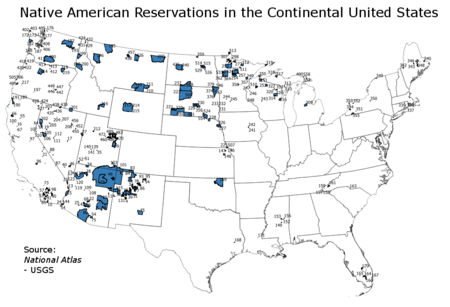Indian country
Indian country is any of the many self-governing Native American communities throughout the United States. As a legal category, it includes "all land within the limits of any Indian reservation", "all dependent Indian communities within the borders of the United States", and "all Indian allotments, the Indian titles to which have not been extinguished."[1][2] This legal classification defines American Indian tribal and individual land holdings as part of a reservation, an allotment, or a public domain allotment. All federal trust lands held for Native American tribes is Indian country. Federal, state, and local governments use this category in their legal processes. Today, however, according to the U.S. Census of 2010, over 78% of all Native Americans live off reservations. Indian country now spans thousands of rural areas, towns and cities where Indian people live.

This convention is followed generally in colloquial speech and is reflected in publications such as the Native American newspaper Indian Country Today.
Related and historical meanings
Historically, Indian country was considered the areas, regions, territories or countries beyond the frontier of settlement that were inhabited primarily by Native Americans. The first grants of land in what is now the United States made by the King of England left it to the grantee to make such arrangements as they were able with the Indians living on the granted land.
Between the Appalachians and Mississippi
As the original 13 colonies grew and treaties were made, the de facto boundary between settled territory and Indian country during the 18th century was roughly the crest of the Appalachian Mountains, a boundary set into law by the Royal Proclamation of 1763, the Confederation Congress Proclamation of 1783, and later by the Nonintercourse Act.[3] The Indian Reserve was gradually settled by European Americans and divided into territories and states, starting with Kentucky County (an extension of Virginia) and the Northwest Territory.
West of the Mississippi
Most Indians in the area of the former Reserve were either killed or relocated further west under policies of Indian Removal. After the Louisiana Purchase, the Indian Intercourse Act of 1834 created the Indian Territory west of the Mississippi River as a destination. It too was gradually divided into territories and states for European American settlement, leaving only modern Indian Reservations inside the boundaries of U.S. states.
In 2020, the United States Supreme Court ruled in McGirt v. Oklahoma that the tribal statistical area (and former reservation) of the Muscogee (Creek) Nation remains under the tribal sovereignty of the Muscogee (Creek) Nation for the purposes of the Major Crimes Act.
See also
References
- "18 U.S.C. 1151". Law.cornell.edu. Retrieved 2012-06-08.
- "What Is Indian Country?". Tribaljurisdiction.tripod.com. Retrieved 2012-06-08.
- Vine Deloria, Jr. and Clifford M. Lytle (1983). "Indian Country". American Indians, American Justice. Austin, Texas: University of Texas Press. ISBN 978-0292738348.
- N. Bruce Duthu, American Indians and the Law (NY: Penguin Library -Viking - 2008)
- David H. Getches, Charles F. Wilkinson, and Robert A. Williams, jr., Cases and Materials on Federal Indian Law, 4th Ed. (St. Paul: West Pub., 1998)
- Imre Sutton, ed., "The Political Geography of Indian Country." American Indian Culture and Research Journal, 15(02) 1991